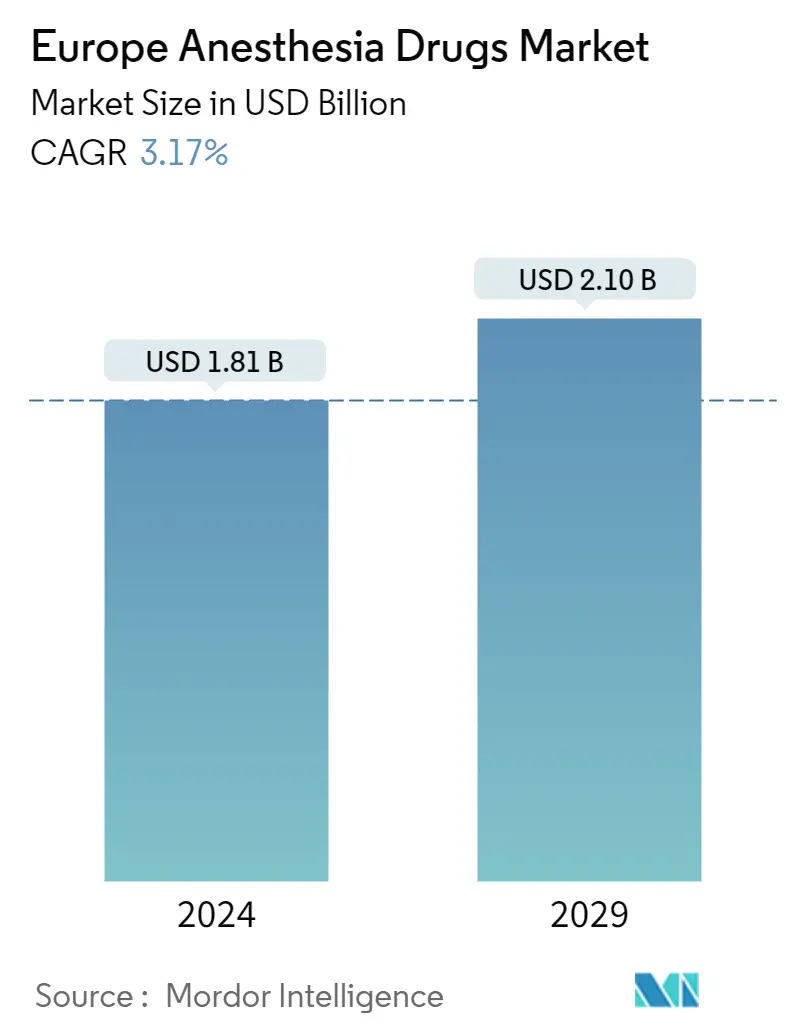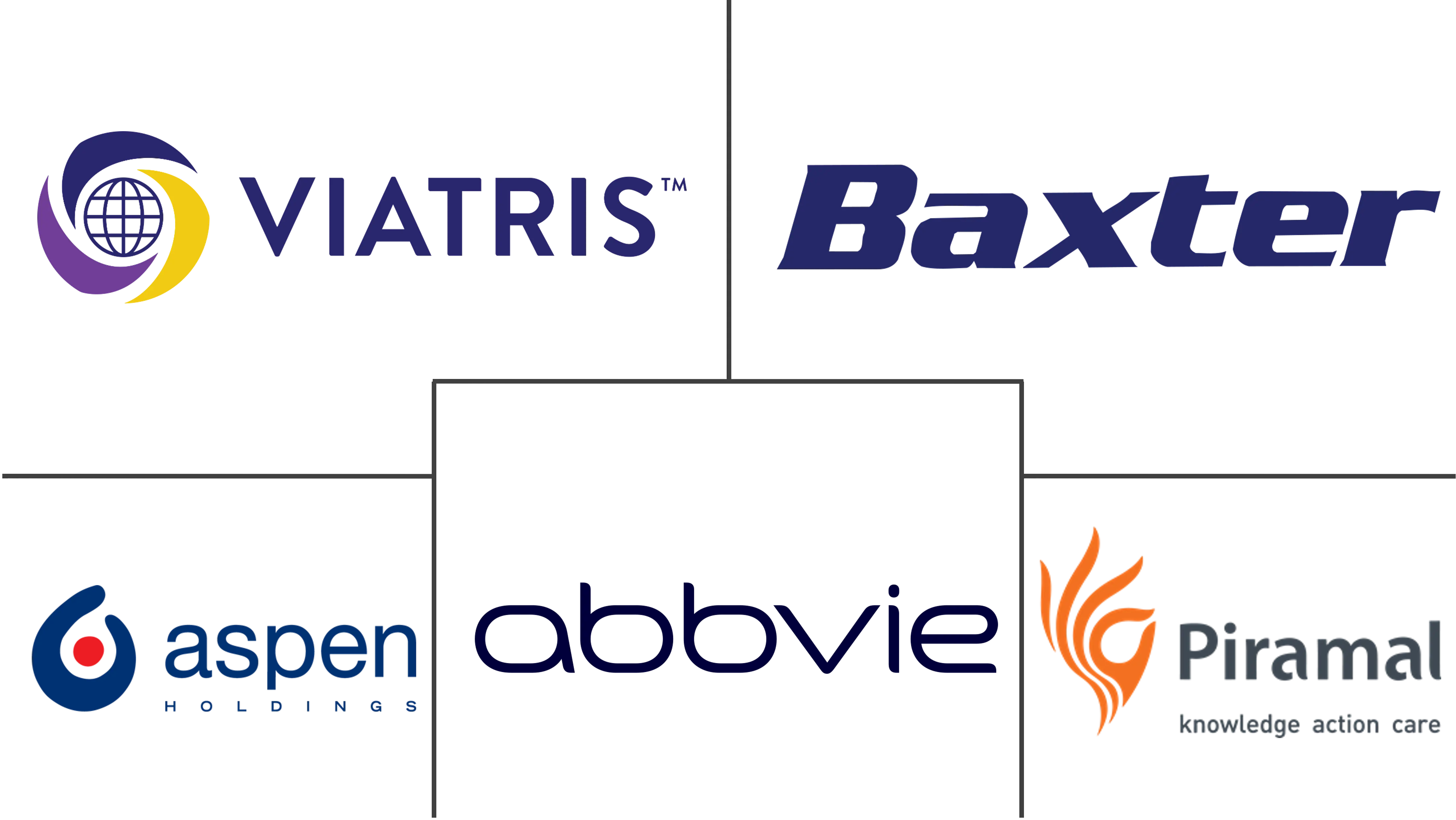Market Size of Europe Anesthesia Drugs Industry

| Study Period | 2019 - 2029 |
| Base Year For Estimation | 2023 |
| Market Size (2024) | USD 1.81 Billion |
| Market Size (2029) | USD 2.10 Billion |
| CAGR (2024 - 2029) | 3.17 % |
| Market Concentration | Medium |
Major Players
*Disclaimer: Major Players sorted in no particular order |
Need a report that reflects how COVID-19 has impacted this market and its growth?
Europe Anesthesia Drugs Market Analysis
The Europe Anesthesia Drugs Market size is estimated at USD 1.81 billion in 2024, and is expected to reach USD 2.10 billion by 2029, growing at a CAGR of 3.17% during the forecast period (2024-2029).
The outbreak of COVID-19 impacted the European anesthesia drugs market, as hospitals and healthcare services were significantly reduced due to the social distancing measures enforced globally. In addition, intensivists and anesthesiologists are teaming up to treat COVID-19 patients. They reported that ventilated COVID-19 patients often require high doses of intravenous sedative drugs, such as propofol, midazolam, ketamine, and dexmedetomidine. As per a research study published in May 2020, titled 'Sedating Ventilated COVID-19 Patients with Inhalational Anesthetic Drugs', patients with severe lung injury from causes other than COVID-19 have shown that inhalational anesthetic drugs improve oxygenation and cause lower mortality, compared to propofol or midazolam. An article titled 'The impact of COVID-19 on anesthesia and critical care services in the UK: a serial service evaluation', published in the journal of Anaesthesia in September 2021, indicated that in January 2021, one-third of the anesthesia staff were unavailable, 42% of operating theaters were closed, and national surgical activity reduced to less than half, including reduced cancer and emergency surgery.
Moreover, the use of inhalational anesthetic drugs for ventilated COVID-19 patients is both practical and cost-effective in low- and high-income countries. These drugs allow sedation levels to be closely and rapidly controlled. These drugs reduce inflammation, dilate airways, and improve oxygenation, thus opening up new horizons for the market.
Certain factors driving the market growth include an increasing number of surgeries, new approvals of anesthetic drugs, and a reduction in the cost of newly invented drugs. In Europe, the number of surgeries being performed is increasing every year. The increase in the number of surgeries performed has a considerable impact on the anesthetics market, as anesthetics are widely used in all surgical procedures to reduce pain during surgery. According to the Royal College of Surgeons of England's data on the surgeries in England, published in May 2021, there were around 4.95 million people in England, waiting for surgery. A large number of surgeries in the region is expected to drive the growth of the anesthesia drugs market over the forecast period.
However, general anesthetic drugs cause several side effects, including nausea, vomiting, dry mouth, sore throat, shivering, muscle aches, disorientation, itching, sleepiness, and mild hoarseness. Other factors such as lack of skilled anesthetics and regulatory issues are restraining the market growth.
Europe Anesthesia Drugs Industry Segmentation
As per the scope of this report, anesthesia is a drug that causes a reversible loss of sensation. There are several types of anesthetics available in the market, such as general anesthesia, spinal anesthesia, IV regional anesthesia, local anesthesia, peripheral nerve block, and saddle block or caudal anesthesia. The Europe anesthesia drugs market is segmented by drug type (general anesthesia drugs (propofol, sevoflurane, desflurane, dexmedetomidine, remifentanil, midazolam, and other general anesthesia drugs) and local anesthesia drugs (bupivacaine, ropivacaine, lidocaine, chloroprocaine, articaine, benzocaine, and other local anesthesia drugs), route of administration (inhalation, injection, and other routes of administration), application (general surgeries, plastic and cosmetic surgeries, dental surgeries, and other applications), and geography (United Kingdom, Germany, France, Italy, Spain, and Rest of Europe). The report offers the market size and forecasts in value (USD million) for the above segments.
| By Drug Type | |||||||||
| |||||||||
|
| By Route of Administration | |
| Inhalation | |
| Injection | |
| Other Routes of Administration |
| By Application | |
| General Surgeries | |
| Plastic and Cosmetic Surgeries | |
| Dental Surgeries | |
| Other Applications |
| Geography | |
| United Kingdom | |
| Germany | |
| France | |
| Italy | |
| Spain | |
| Rest of Europe |
Europe Anesthesia Drugs Market Size Summary
The European anesthesia drugs market is poised for steady growth over the forecast period, driven by an increasing number of surgeries and advancements in anesthetic technologies. The market experienced disruptions due to the COVID-19 pandemic, which led to a temporary decline in surgical procedures and a shift in the use of anesthetics, particularly with the increased need for sedation in ventilated COVID-19 patients. Despite these challenges, the market is expected to recover and expand, supported by the rising demand for both plastic and cosmetic surgeries, which rely heavily on anesthesia. The availability of new anesthetic drugs and the reduction in their costs are further propelling market growth, as these factors enhance the safety and efficacy of surgical procedures across Europe.
Germany is anticipated to hold a significant share of the market, bolstered by its robust healthcare infrastructure, increasing geriatric population, and a high prevalence of chronic diseases necessitating surgical interventions. The country's focus on advancing anesthesiology, coupled with the rising number of surgical procedures, particularly in plastic and cosmetic surgery, is expected to drive market expansion. The competitive landscape of the European anesthesia drugs market is characterized by the presence of major players such as AbbVie Inc., B. Braun Melsungen AG, and Fresenius SE & Co. KGaA, who are actively engaged in product launches and strategic partnerships to enhance their market positions. These developments, along with regulatory approvals for new anesthetic products, are likely to positively influence the market dynamics in the coming years.
Europe Anesthesia Drugs Market Size - Table of Contents
-
1. MARKET DYNAMICS
-
1.1 Market Overview
-
1.2 Market Drivers
-
1.2.1 Increasing Number of Surgeries and Emergency Cases
-
1.2.2 Growing Geriatric Population and Rising Prevalence of Chronic Diseases
-
-
1.3 Market Restraints
-
1.3.1 Side Effects of Anesthesia Drugs
-
1.3.2 Increasing Usage of Generic Anesthesia Drugs and Lack of Skilled Anesthesiologists in European Countries
-
-
1.4 Porter's Five Forces Analysis
-
1.4.1 Threat of New Entrants
-
1.4.2 Bargaining Power of Buyers/Consumers
-
1.4.3 Bargaining Power of Suppliers
-
1.4.4 Threat of Substitute Products
-
1.4.5 Intensity of Competitive Rivalry
-
-
-
2. MARKET SEGMENTATION (Market Size by Value - USD Million)
-
2.1 By Drug Type
-
2.1.1 General Anesthesia Drugs
-
2.1.1.1 Propofol
-
2.1.1.2 Sevoflurane
-
2.1.1.3 Desflurane
-
2.1.1.4 Dexmedetomidine
-
2.1.1.5 Remifentanil
-
2.1.1.6 Midazolam
-
2.1.1.7 Other General Anesthesia Drugs
-
-
2.1.2 Local Anesthesia Drugs
-
2.1.2.1 Bupivacaine
-
2.1.2.2 Ropivacaine
-
2.1.2.3 Lidocaine
-
2.1.2.4 Chloroprocaine
-
2.1.2.5 Articaine
-
2.1.2.6 Benzocaine
-
2.1.2.7 Other Local Anesthesia Drugs
-
-
-
2.2 By Route of Administration
-
2.2.1 Inhalation
-
2.2.2 Injection
-
2.2.3 Other Routes of Administration
-
-
2.3 By Application
-
2.3.1 General Surgeries
-
2.3.2 Plastic and Cosmetic Surgeries
-
2.3.3 Dental Surgeries
-
2.3.4 Other Applications
-
-
2.4 Geography
-
2.4.1 United Kingdom
-
2.4.2 Germany
-
2.4.3 France
-
2.4.4 Italy
-
2.4.5 Spain
-
2.4.6 Rest of Europe
-
-
Europe Anesthesia Drugs Market Size FAQs
How big is the Europe Anesthesia Drugs Market?
The Europe Anesthesia Drugs Market size is expected to reach USD 1.81 billion in 2024 and grow at a CAGR of 3.17% to reach USD 2.10 billion by 2029.
What is the current Europe Anesthesia Drugs Market size?
In 2024, the Europe Anesthesia Drugs Market size is expected to reach USD 1.81 billion.

